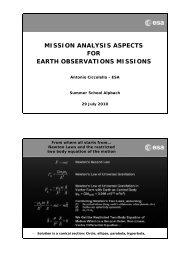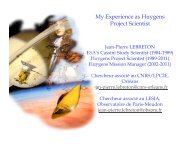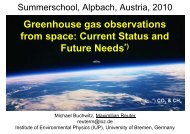Thirty-Something Slides About Satellites and Rings
Thirty-Something Slides About Satellites and Rings
Thirty-Something Slides About Satellites and Rings
- No tags were found...
You also want an ePaper? Increase the reach of your titles
YUMPU automatically turns print PDFs into web optimized ePapers that Google loves.
<strong>Thirty</strong>-<strong>Something</strong> <strong>Slides</strong> <strong>About</strong> <strong>Satellites</strong> <strong>and</strong> <strong>Rings</strong>T. Spohn, DLR-PF, Berlin
6Large <strong>Satellites</strong>, Small Planets
Radius vs DensityDichte ist unmittelbar mit der chemischen Zusammensetzung korreliert
Density - Size
JupiterNeptuneUranus
Saturn: <strong>Rings</strong>CassiniDivisionEnckeDivisionD C B AFPIA06175E
Danke an T. Denk/FUB
ENCELADUS: Ice geysers near south poleISS-image
„Tiger stripes“(South pole area)ENCELADUS
Titan
360º-Panorama from 14km height
NAn (active)Cryovolcanoeon Titan?Titan0°/ 150°E26. 10. 2004Spiral (Snake) Structure20 km
Lakes of carbonhydrates on Titan?
Mir<strong>and</strong>a <strong>and</strong> Triton
The Galilean <strong>Satellites</strong>: Four Different Worlds
Ganymede in the Jovian MagnetosphereCredit: S. Barlett
Models of Interior Structure25
ConstraintsMass, Radius, GravitySurface volcanism, heat flow, <strong>and</strong> temperature at IoMagnetic induction signals observed at Europa,Ganymede <strong>and</strong> CallistoMagnetic field observed at GanymedeSurface geologySpectroscopy <strong>and</strong> chemistry
Radau-Darwin-RelationHydrostatic Equlibrium assumed!
Simple Two-Layer ModelMIMR2P43 RP R32 Rc15 RP3c5mRm3c c R RcP5 c Ambiguity: three unknowns, two pieces of dataNote:IMR2PCMR2P2 J32Folie 28 > Spohn
<strong>Satellites</strong>: DataIo Europa Ganymede Callisto Titan MoonMass (10 20 kg) 894. 480. 1482. 1077. 1340. 735.Radius (km) 1816. 1569. 2631. 2400. 2575 1738..Density (kg m -3 ) 3570. 2970. 1940. 1860. 1880. 3340.C/MR² 0.378 0.346 0.3105 0.358 ? 0.393Heat flow (pW/kg) 890 150 ? ? ? 829Dokumentname > 23.11.2004
Interior Structure: GanymedeThe small value of the MoIfactor (0.3105) suggests a 3-layer structure with an Fe-richcore, a silicate mantle <strong>and</strong> anice shell of roughly equalthickness (900 km)Galileo magnetometer data byKivelson et al. (2002) suggestthere may be an ocean <strong>and</strong> aself-sustained magnetic fieldThe magnetic field suggests aniron-rich core30
Internal OceansThe icy satellites Europa,Ganymede, Callisto, Titan,Triton,... may have internaloceansCompetition between heattransfer <strong>and</strong> heating ratesMelting point gradient31
Equilibrium ModelNu = a Ra 0.25 , k = 3.3 W m -1 K –1 , A=24, H=4.5 pW kg –1Heat TransferCallisto u.Ganymede,Callisto d.Titan EuropaTidal HeatingConvectivelidConductivelidHeat Production 33
Ammonia (5 wt.%)Heat TransferGanymede,Callisto d.Titan EuropaConvectivelidConductivelidCallisto u.34Heat Production
Laplace Resonance1:2:435
Io‐Europa Thermal‐Orbital Evolution37
Conclusions<strong>Satellites</strong> of Uranus <strong>and</strong> Neptune largelyunexploredIo, still a puzzle in terms of its orbital evolution<strong>and</strong> heat flowTitan <strong>and</strong> Europa, the astrobiologist‘s darlingsOceans, possibly in many icy satellitesTitan <strong>and</strong> Callisto mostly undifferentiated. Howwould you do that?Ganymede the only magnetically active satellite.To some this is a puzzle who would rather seeEuropa produce a magnetic fieldTidal heating an important energy source in theouter solar system





